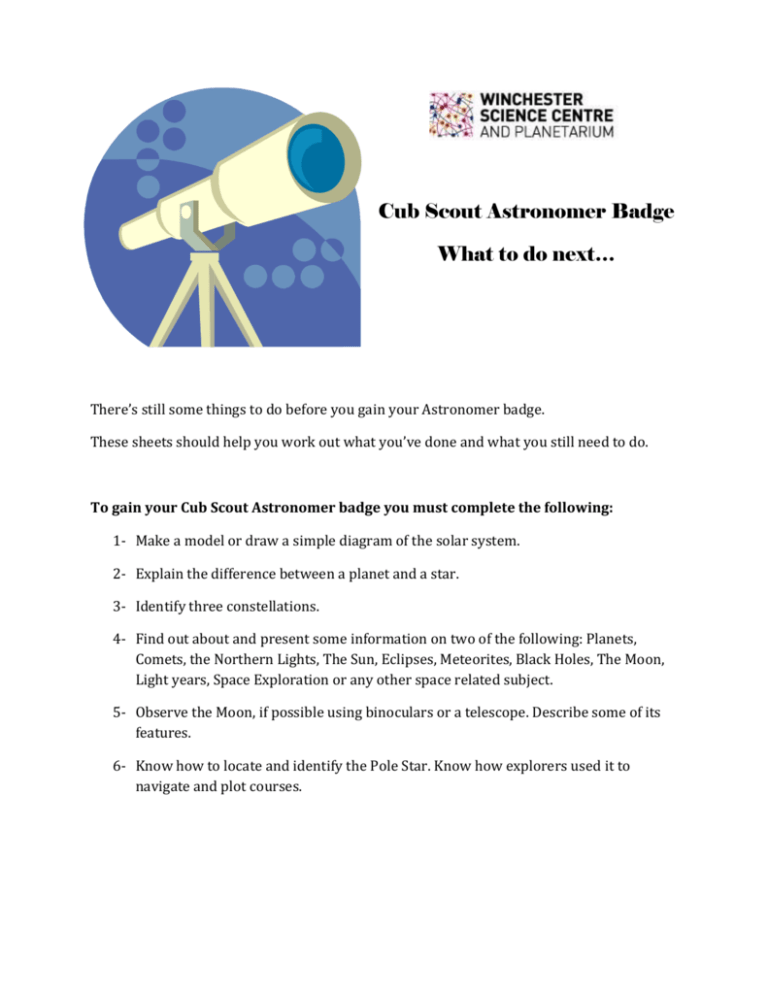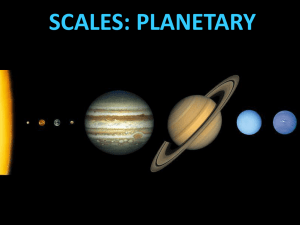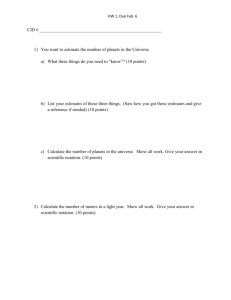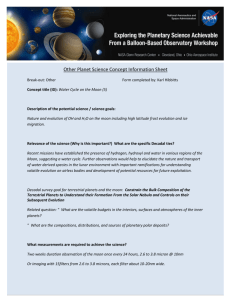Winchester Science Centre & Planetarium
advertisement

Cub Scout Astronomer Badge What to do next… There’s still some things to do before you gain your Astronomer badge. These sheets should help you work out what you’ve done and what you still need to do. To gain your Cub Scout Astronomer badge you must complete the following: 1- Make a model or draw a simple diagram of the solar system. 2- Explain the difference between a planet and a star. 3- Identify three constellations. 4- Find out about and present some information on two of the following: Planets, Comets, the Northern Lights, The Sun, Eclipses, Meteorites, Black Holes, The Moon, Light years, Space Exploration or any other space related subject. 5- Observe the Moon, if possible using binoculars or a telescope. Describe some of its features. 6- Know how to locate and identify the Pole Star. Know how explorers used it to navigate and plot courses. Activity 1 - Make a model or draw a simple diagram of the Solar System You will have: Been introduced to the Solar System in our planetarium. You will have found out some facts about Mars and Saturn in the quizzes and noticed the differences between the small rocky planets and the larger gas giants. You will need to: Make a model or simple diagram of the solar system. You can make this with your cub pack, where each one of you stands in the position of a planet. Activity 2 - Explain the difference between a planet and a star You will have: Visited our planetarium and found out that stars make their own light, whilst the planets and moons in our solar system reflect the light of our Sun. You will have found that although the planets sometimes appear brighter than the stars this is because the planets are very, very much closer than even the nearest star. You will need to: Explain this to your assessor. Activity 3 – Identify three constellations You will have: In our planetarium you will have been introduced to the constellation of The Great Bear (where you can find the Plough), the Little Bear and Cassiopeia (the Queen). You will have made some constellation pictures as well. You will need to: See if you can identify three of them for your assessor. Activity 4 - Find out about and present some information on two of the following: Planets, Comets, the Northern Lights, The Sun, Eclipses, Meteorites, Black Holes, The Moon, Light years, Space Exploration or any other space related subject. You will have: Been introduced to the Sun and planets, the phases of the moon and other topics in our planetarium. You will have learnt some facts about Mars and Saturn on the quiz. You will need to: Talk about two of these topics with your assessor or present your information to the rest of your Cub Scout pack. You might like to choose a different astronomical topic if you are more interested in something else. Tips for presenting your information: If you are presenting to your fellow cubs don’t say too much. It is better to keep it simple rather than over complicated. Try not to use complicated names and words and explain what they mean if you do use them. Know the topic well and tell it in your own words rather than reading something out. It feels more natural and you can look at your audience, rather than the page. Having props or pictures can help you, but you don’t need to have them to help present your information - Enjoy yourself and have fun! Activity 5 - Observe the Moon, if possible using binoculars or a telescope. Describe some of its features. You will have: Been introduced to the Moon in our planetarium. You should know that the moon doesn’t make its own light, but reflects the light of our Sun. This gives the Moons phases. You have made a flick book to show the moons phases. You will need to: Observe the moon in the night sky. Tips for looking at the moon: A full Moon is very bright, so often it is better to observe the moon when it is at half or crescent phase. The line between day-time and night-time on the moon is called the terminator. This is a good place to look as the detail of the craters and the mountains is clearer. If you use binoculars, resting your arms on a low wall or use a tripod will help keep them steady. Activity 6 - Know how to locate and identify the Pole Star (North Star). Know how explorers used it to navigate and plot courses. You will have: Found out that the North Star (Polaris) is an ordinary star in an interesting position. By using two stars at the end of the Plough (opposite the handle!) as pointers, you can find the North Star. Because it is almost directly above the North Pole it remains in the same place as the other stars all appear to move around it through the night. The nearest horizon to the North star is North, sailors and other travellers used this star to navigate. They could tell their latitude by working out how high Polaris was in the sky. You will have found the North Star on the star map and in the planetarium. You will need to: Explain this to your assessor.









